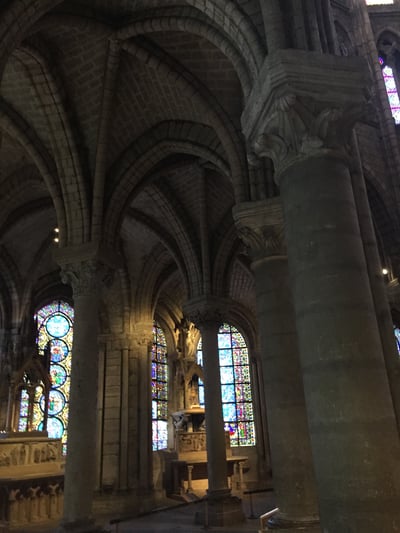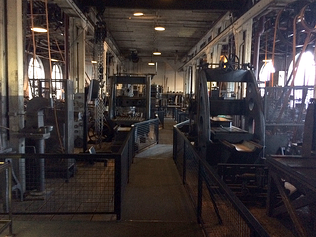Blog
ELearning Design: The Eye of the Beholder
By Ethan Edwards, Chief Instructional Strategist / @ethanaedwards I had the great good fortune of traveling to Paris in March. I spent a couple of ...


Je n’en crois pas mes yeux! Unexpected E-Learning Insights in a French Cathedral
By Ethan Edwards | April 21, 2016 | Custom Learning | 0 Comments
By Ethan Edwards, Chief Instructional Strategist / @ethanaedwards
 I had the great good fortune of traveling to Paris in March. I spent a couple of days engaged in consulting work, and then added a few extra days just to be a tourist. I’d never been to France before, and I was delighted to spend three or four days exploring a place filled with so much history, art, and culture.
I had the great good fortune of traveling to Paris in March. I spent a couple of days engaged in consulting work, and then added a few extra days just to be a tourist. I’d never been to France before, and I was delighted to spend three or four days exploring a place filled with so much history, art, and culture.
In previous travels, I’ve developed an appetite for Gothic architecture. I gained an interest in Gothic architecture before I arrived in France when I visited the great medieval cathedrals of England. I was eager to see the differences between how this architectural movement developed in France (where Gothic is thought to have originated) compared to how it took off in England.
The Inspiring Gothic Architecture of the Basilica Cathedral of Saint-Denis
 So I rode a Paris Metro line nearly to its end to see the Basilica Cathedral of Saint-Denis. This ancient Abbey church is the final resting place for nearly all of the French kings and Europe’s most extensive collection of recumbent funerary sculpture. More interesting to me, however, this church is also recognized as the first significant structure to be built in what would become the Gothic style of architecture that dominated public buildings for 400 years.
So I rode a Paris Metro line nearly to its end to see the Basilica Cathedral of Saint-Denis. This ancient Abbey church is the final resting place for nearly all of the French kings and Europe’s most extensive collection of recumbent funerary sculpture. More interesting to me, however, this church is also recognized as the first significant structure to be built in what would become the Gothic style of architecture that dominated public buildings for 400 years.
Though much modified and altered in the course of the 900 years since its construction began in 1140 A.D., the western façade of the church and the apsidal chevet around the choir illustrate the hallmark defining features of this distinctive style brought together for the first time in a single major structure. These features include the pointed arch, vaulted ceilings, slender columns, large windows filled with stained glass, flying buttresses, and unified narrative stone carving and ornamentation.
All of these elements didn’t appear suddenly, out of thin air. The Romanesque architecture that was common before this revolution in style included many of these elements, but they were only found in isolated and fragmented examples. But it took a visionary—Abbot Suger—to create something truly revolutionary.
It was overwhelming for me to stand in that space, where a new design destined to inspire construction for centuries came into being. And it is worth considering the wonder of this design effort, not just the technical prowess of the construction technique.
The Elevated Design of Abbot Suger
Like all design efforts, a significant problem needed to be addressed. If the goal was just to create a shelter and location for worship, there was no need to abandon the Romanesque style and design something different. But the traditional architecture failed to achieve a much less tangible, but more important, purpose of a church: to elevate the wonder and devotion in the worship of God. Abbot Suger and his builders tried something new. They replaced the heavy barrel vaults with lighter and higher vaulted ceilings. Suger and his team perched the vaults on slender pillars that supported these high arches made possible by the counteracting support of flying buttresses and stone pinnacles. This strong framing structure eliminated the heavy stone support walls and replaced them with vast and colorful stained glass windows. The combination of these design elements created an internal space as light and sparkling as a jewel box.

These builders weren’t motivated to use pointed arches or to construct flying buttresses as an end in themselves. No, these designers were driven to inspire by creating a new experience that elevated the human spirit through height, space, and color. I’m certain there were many trials and false starts in the development of these techniques. In my reading, I actually learned about Amiens Cathedral that, while still standing, had some critical original structural flaws due to faulty design that required various patches over the centuries. For instance, the builders hadn’t placed the flying buttresses appropriately to support the tall walls and the whole building had to be “belted” with iron chain work to keep the walls from buckling. But even mistakes are not errors when trying something new, but rather are something to be expected and learned from.
The Parallel to e-Learning Design
I was struck by the parallel that seems to keep too many e-learning designers in recreating modules that technically “work,” but do nothing to strive for the higher purpose of any training program: engaging the learner’s mind and actions in achieving valued performance outcomes. It seems that nearly everyone I encounter who designs e-learning is dissatisfied with the long-accepted models of information presentation and immediate comprehension questions. Design elements like audio or narration or even special drag-and-drop gestures are used but not in a way that adds up to anything significant. This is the model that almost all authoring tools seem optimized to support. Just as Romanesque architecture provided a very solid space but without elevating the experience, these examples of e-learning serve as an accomplishment little more than an item to be checked off instead of training to be celebrated and expanded.
Striving to Create Irresistible e-Learning
Like Abbot Suger, we need to design for an outcome that our learners value. The incomparable spiritual uplift, communicated through stone and glass that this medieval monk envisioned, continues to speak to the observer today. For e-learning designers, our elevated purpose must be irresistible e-learning that engages and activates the learner’s mind to achieve and maintain meaningful performance. For Abbot Suger, the tools he used to achieve his ends were the known but poorly-used elements of the pointed arch, the vaulted ceiling, the flying buttress, etc. We designers of e-learning have a similarly powerful but underused set of tools to use in building our modules: meaningful context, goal-driven challenges, modulated risk, real-world focused actions, and intrinsic feedback to embed meaning in activities.
Later in my visit, I also toured the magnificent chapel of Sainte-Chapelle in Paris and the Cathedral of Our Lady in nearby Chartres. These magnificent triumphs of stone and glass in some ways put the Sainte-Denis Abbey to shame, but it is vital to remember that they would never have been possible had someone like Abbot Suger not first had the courage and vision to break from the tradition that was holding the world back, and to create something new and transformative.
I hope you might capture some inspiration and courage to abandon that which we know doesn’t work, and instead, attempt to create the kind of e-learning that is all too easily dismissed as impossible.
LIKE WHAT YOU'VE READ? SHARE THE KNOWLEDGE WITH YOUR PEERS USING THIS READY-MADE TWEET!
CLICK TO TWEET: Je n’en crois pas mes yeux! Unexpected #eLearning Insights in a French Cathedral http://hubs.ly/H02LGBH0

About the Author: Ethan Edwards
Ethan Edwards draws from more than 30 years of industry experience as an elearning instructional designer and developer. He is responsible for the delivery of the internal and external training and communications that reflect Allen Interactions’ unique perspective on creating Meaningful, Memorable, and Motivational learning solutions backed by the best instructional design and latest technologies.
Comments
Would you like to leave a comment?
Related Blog Posts

By: Ethan Edwards | Mar, 2017
Category: Custom Learning

Blog
Go Beyond Sizzle & Fizzle: Create Learning that Delights
By Ethan Edwards, Chief Instructional Strategist / @ethanaedwards I had the great good fortune of traveling to Paris in March. I spent a couple of ...
By: Ethan Edwards | Jun, 2014
Category: Custom Learning

Blog
Be an Inventor: The Importance of Prototyping for e-Learning Design
By Ethan Edwards, Chief Instructional Strategist / @ethanaedwards I had the great good fortune of traveling to Paris in March. I spent a couple of ...
By: Ethan Edwards | Jan, 2015
Category: Custom Learning

